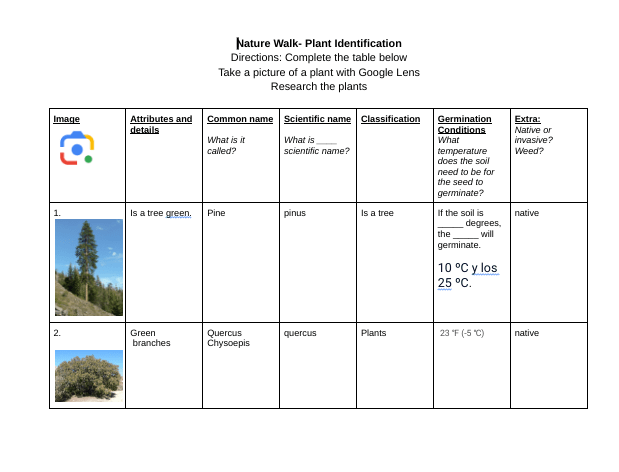Now on to language for science!
On a warm sunny fall day, I took my students outside to take pictures of 10 or more plants around the school. They worked in pairs. One snapped photos with their Chromebook and the other wrote attibutes and details they both noticed about the plant. The appreciation was deep–first to get outside and soak in the autumn sun, second to learn more about the plants that we see daily around our school environment.
The next day I taught the students how to created a folder in their Google Drive, upload pictures, and share the folder with their partner. After completion, they worked collaboratively to complete a table with their plant data, exposing them to another type of graphic organizer and its function. They reverse searched their plant pictures in Google lens to identify the plants. With that information they could research the other questions in the table.
Multiple Meaning Words: Language Learning Support
I used this word “table” as a catalyst to discuss multiple meaning words, which can often be tricky for second language learners. I asked, “What does ‘table’ mean?” They immediately responded, “Mesa!” “You’re not wrong, but in English ‘table’ can mean something different depending on the context. In this context, a ‘table’ is a graphic organizer, which organizes information in rows and columns. In Spanish, it is called a ‘tabla.’ So how do you know the difference? Well, would you eat at a graphic organizer? Not really. It’s the context which tells us which ‘table’ is being used. But let’s table multiple meaning words for now.
Writing: Research
The students then worked together to research the plants.

Upon its completion, I gave them the short think, pair, share reflection assignment below. Referring to their data, students had to write their individual opinions. Then, they orally discussed their individual opinions with their group. Last, they had to decide on a group response for the same questions then present out. One student remarked–I love this project! My favorite question was which of these plants could you identify without Google lens? And aside from pine trees and tomatos, most all were new. They deepened their vocabulary, learned technology, grew an appreciation for local Virginian flora, and collaborated in their written and oral responses.
